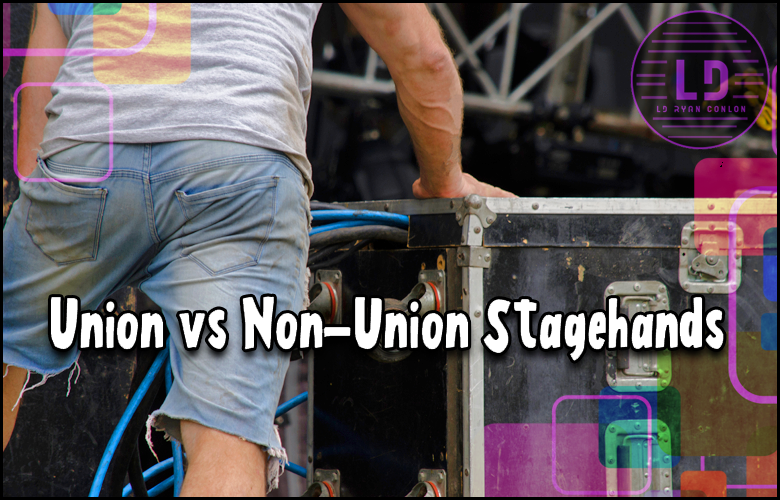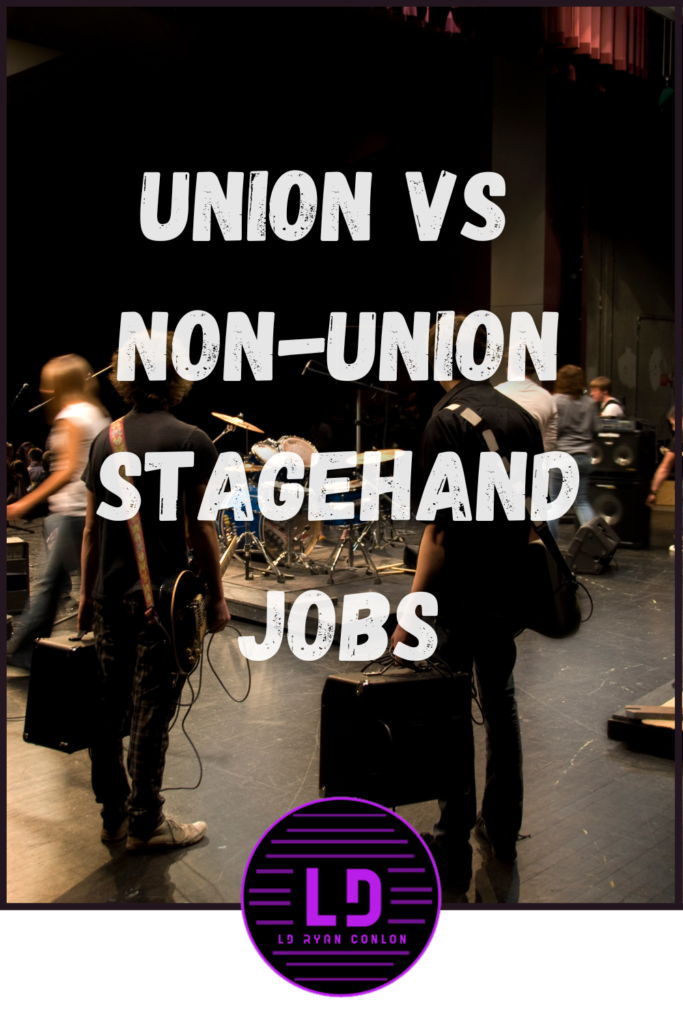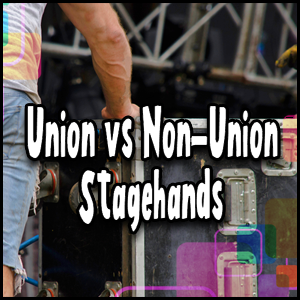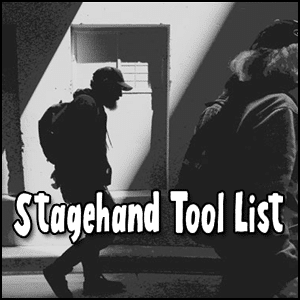
Last Updated on May 3, 2025 by LD Ryan Conlon | 🕒 6 min Read Time
Breaking into the world of stagehand jobs can be a daunting task, with questions swirling around your head — is it better to ally yourself with a union or take the non-union route?
These decisions will shape not only your career prospects but also your entire professional journey within the theatrical industry.
To help you unravel this complex maze, we delve into a comprehensive analysis of Union vs Non-Union Stagehand jobs — their pros and cons, as well as future career opportunities.
Dive in and equip yourself with knowledge that could steer your theatrical ship towards an exciting destination uncharted by many aspiring backstage heroes.
Union stagehands are members of labor organizations that negotiate contracts with employers to secure better wages, working conditions, and benefits for their members.
They adhere to established work rules and have access to training and advancement opportunities.
On the other hand, non-union stagehands do not belong to such organizations and may be hired on a project-by-project basis without the benefits and protections offered by unions.
It is important to note that specific details regarding union requirements and benefits can vary based on the organization.
Comparing Unionized and Non-Union Stagehands
When it comes to stagehand jobs, there are two primary paths you can take: unionized or non-union.
Each option presents its own set of benefits and drawbacks, and understanding the differences is essential for making an informed decision about your career.
Let’s explore some key aspects of both unionized and non-union stagehand jobs.
Unionized Stagehands: Working in a unionized environment offers several advantages.
Unions like IATSE (International Alliance of Theatrical Stage Employees), SAG-AFTRA (Screen Actors Guild–American Federation of Television and Radio Artists), and DGA (Directors Guild of America) negotiate contracts that ensure fair wages, benefits, safe working conditions, and other rights for their members.
These unions advocate for their members’ interests and prioritize industry standards.
For example, let’s say you join IATSE as a stagehand.
You would benefit from having negotiated pay rates based on experience and skills, ensuring you receive competitive compensation for your work.
Additionally, you would have access to healthcare coverage, retirement plans, job security, professional development opportunities, and a collective bargaining agreement that protects your rights on set.
Non-union stagehand positions, on the other hand, offer a different set of circumstances.
In these roles, pay rates can vary significantly depending on the production company, location, and level of experience.
While some non-union productions may offer competitive rates, others might provide lower compensation compared to their unionized counterparts.
Benefits such as healthcare coverage or retirement plans may be limited or nonexistent in non-union positions.
However, there are also unique opportunities available when working as a non-union stagehand.
These roles often provide valuable experience for those starting their careers in the industry.
It allows individuals to build their portfolios while exploring different roles and genres.
Non-union productions can also offer flexibility, allowing stagehands to work on a variety of projects and gain exposure to different production styles.
It’s important to note that non-union work requires network building and reputation building.
Since there are no union protections in place, stagehands may face challenges such as longer hours, lack of overtime pay, and potential exploitation.
Therefore, it’s crucial to research industry standards and understand your rights before accepting non-union positions.
Some argue that the stability and benefits provided by unionized stagehand jobs outweigh the potential risks and uncertainties of non-union work.
Unionized positions often provide stronger job security, regular work schedules, access to training programs, and collective representation.
On the other hand, non-union positions can be advantageous for those seeking a more flexible working environment or looking to gain diverse experience quickly.
Now that we have compared unionized and non-union stagehand jobs from an overall perspective, let’s dive deeper into another important aspect: the contrast between security and benefits.
Security & Benefits Contrast
When evaluating different job options as a stagehand, considering the level of security and the benefits available is paramount.
Unionized stagehand positions typically come with more robust job security due to the negotiated contracts between unions and employers.
These contracts establish clear guidelines for hiring practices, job retention, layoffs, and termination procedures.
Being part of a union ensures that your rights are protected and that employers must adhere to specified protocols when making employment decisions.
In addition to job security, unionized stagehands enjoy various benefits.
These can include competitive wages based on experience and skill level, health insurance coverage, retirement plans (such as pensions or 401(k) contributions), disability insurance, paid time off (including vacation days and sick leave), access to training programs for professional development, and in some cases, even housing assistance for those working on touring productions.
Consider the example of a unionized stagehand who has worked for several years.
They would likely have a steady income, know their schedule well in advance, and have access to benefits that provide financial security and support.
Non-union stagehand positions may not offer the same level of job security or comprehensive benefits as their unionized counterparts.
Since there are no negotiated contracts in place, employers have greater flexibility when it comes to hiring and retaining employees.
This can result in job instability with no guarantees of continued work or consistent schedules.
Benefit packages for non-union stagehands can also be more limited.
Pay rates may vary widely depending on factors such as location, production size, and your level of experience.
Non-union positions may not offer health insurance coverage or retirement plans. Paid time off and other benefits may be minimal or non-existent.
Think of unionized stagehand jobs as having a secure safety net beneath you, providing stability and protection during your journey.
In contrast, non-union positions can be like walking on a tightrope without a net – offering freedom but also introducing uncertainties and risks.
Ultimately, choosing between unionized and non-union stagehand jobs requires careful consideration of your priorities, circumstances, and long-term goals.
It’s important to educate yourself on industry standards, understand your rights, and leverage platforms like Staff Me Up to explore available opportunities and navigate the right path for your career.
Wage Gap Analysis Between the Two
When considering career options as a stagehand, it is crucial to analyze the wage gap between union and non-union positions.
Union stagehand jobs are typically governed by collective bargaining agreements negotiated between the union and employers, ensuring standardized wages and benefits for workers.
On the other hand, non-union stagehand work often lacks this level of protection and can lead to discrepancies in pay.
To understand the extent of this wage gap, let’s delve deeper into the factors that contribute to it.
One primary factor affecting wages is the union’s ability to negotiate higher rates based on market value and industry standards.
These negotiated agreements aim to ensure fair compensation and protect workers’ rights.
Additionally, unions often have established wage scales that dictate minimum pay rates based on various job roles or experience levels.
On the contrary, non-union stagehands may face more uncertainty when it comes to compensation.
Without collective bargaining power, individuals may have to rely on their negotiation skills to secure adequate pay for their services.
This lack of standardized wages can result in lower rates overall.
For instance, a unionized stagehand might earn $30 per hour for their work, while a non-union stagehand performing similar tasks could potentially receive only $20 per hour.
Furthermore, unionized stagehands often enjoy additional benefits beyond their hourly wage.
These benefits can include healthcare coverage, retirement plans, paid time off, and job security.
Non-union workers might not have access to these perks or have to seek them independently at an additional cost.
It is important to note that while unionized positions offer higher wages and benefits in general, there may be exceptions depending on the specific circumstances and individual negotiations.
Each production or venue has its own unique considerations that can impact compensation.
Some argue that non-union positions provide flexibility and opportunities for individuals who prefer shorter-term contracts or have varying schedules.
While this may be true to some extent, it is essential to weigh the potential financial drawbacks against the perceived advantages of non-union work.
Understanding the wage gap between union and non-union stagehand jobs allows individuals to make informed decisions about their career path.
While higher wages and benefits are often associated with union positions, it is vital to consider all factors, including personal preferences, long-term stability, and overall job satisfaction.
Dissecting Non-Union Stagehand Work
Non-union stagehand work refers to positions in the entertainment industry that are not governed by a collective bargaining agreement or union representation.
These jobs provide flexibility for individuals who prefer shorter-term contracts or have specific project-based requirements.
For instance, non-union stagehands often find employment in smaller theaters, corporate events, concerts, or local productions that do not require the consistency of unionized labor.
Working as a non-union stagehand can offer valuable opportunities for building experience, networking with industry professionals, and exploring various aspects of the entertainment field.
However, it’s important to recognize certain considerations when pursuing this path.
One key aspect of non-union work is that individuals may need to negotiate their rates directly with employers or production companies.
This requires understanding industry standards and advocating for fair compensation based on skills and experience.
Additionally, non-union workers might not always receive the same level of job security and benefits as their union counterparts.
They may need to navigate fluctuating gig-based employment and handle their healthcare coverage or retirement planning independently.
Think of it like freelancing in any other profession. While there is freedom in choosing projects and managing your schedule, you must also handle billing, marketing yourself, and ensuring financial stability without the support of a larger organization.
It’s essential for non-union stagehands to continuously seek opportunities for professional development and expand their skill set.
This can involve pursuing specialized training, attending workshops or conferences, and staying updated with industry trends.
While non-union stagehand work offers flexibility and exposure to a variety of projects, it’s crucial to evaluate the potential trade-offs in terms of financial stability, benefits, and job security.
Understanding the nature of these positions will help individuals make informed decisions about their career path.
Career Opportunities for Freelance Stagehands
For those seeking flexibility and variety in their work as a stagehand, freelance opportunities can offer an exciting and dynamic career path.
Freelance stagehands have the freedom to choose the projects they want to be involved in and can gain exposure to a wide range of productions, events, and venues.
This flexibility allows them to explore different aspects of stage production, honing their skills and expanding their network along the way.
One of the primary advantages of working as a freelance stagehand is the ability to take on multiple projects simultaneously.
For example, you might find yourself working on a theater production one week, a music festival the next, and then assisting with a corporate event shortly after that.
This diversity not only keeps the job interesting but also provides valuable experience in various technical areas such as lighting, sound, video, and props.
Imagine being part of a team setting up an elaborate concert stage for a popular band one day and then helping transform a conference hall into a captivating set for a corporate presentation the next.
The possibilities are vast and ever-changing.
Of course, freelancing comes with its challenges.
As a freelance stagehand, you are responsible for finding your own gigs and ensuring a steady stream of work.
It requires excellent networking skills, building relationships with production companies, event organizers, and other industry professionals who may be able to connect you with new opportunities.
Additionally, freelancers need to be adaptable and quick learners.
Given the variety of projects they encounter, they must be ready to adjust to different work environments and handle various equipment setups efficiently.
This adaptability helps them stay competitive in a fast-paced industry where new technology and techniques constantly emerge.
At times, freelancers may face periods of unpredictability in terms of workload or financial stability.
However, building a solid reputation based on reliability and professionalism can lead to consistent referrals for future gigs.
While freelance stagehand work offers its own unique pros and challenges, let’s now shift our focus to examining the world of union stagehand jobs and the opportunities it presents.
- Freelancing as a stagehand can provide exciting and diverse career opportunities, allowing individuals to choose the projects they want to work on and gain experience in different areas of stage production. It offers the chance to work on a wide range of productions, events, and venues, keeping the job interesting and providing exposure to various technical aspects. However, freelancers must be proactive in finding gigs and building their network. They need to be adaptable and quick learners to handle different environments and equipment setups efficiently. Although there may be periods of unpredictability, establishing a strong reputation can lead to consistent referrals for future work.
Scrutinizing Union Stagehand Work
Union stagehand jobs provide a different avenue for those seeking stability, comprehensive benefits, and long-term career opportunities in the entertainment industry.
Unions such as IATSE (International Alliance of Theatrical Stage Employees) advocate for fair wages, safe working conditions, and benefits like healthcare and retirement plans.
For instance, being a member of a union can offer you access to higher-paying gigs compared to freelance work.
Many major theater productions, concerts, and live events require skilled professionals who are part of recognized labor unions.
By being part of a union, you have the opportunity to work on large-scale productions that come with higher salaries and more extensive job security.
Think of joining a union as joining a team with collective bargaining power – together, the members have stronger negotiating leverage when it comes to securing fair pay, reasonable working hours, and improved working conditions.
Working as a union stagehand also provides additional benefits like health insurance coverage and retirement plans.
These benefits help ensure that you are supported both during your working years and in your post-retirement life.
However, becoming a union member typically involves meeting specific requirements set by the union itself.
These requirements may include completing certain training programs or accumulating a specific number of work hours in the industry.
It’s important to note that union stagehand jobs often come with more rigid schedules and less flexibility compared to freelancing.
As part of a union, you may be subject to seniority rules which determine priority for job assignments.
While this can offer stability once you’ve established yourself within the union, it may limit your ability to choose projects independently.
Ultimately, whether you choose to pursue freelance stagehand work or join a union depends on your personal preferences, long-term goals, and the level of stability you seek.
Some individuals thrive in the ever-changing world of freelancing, relishing the variety and freedom it offers.
Others find comfort and security in the comprehensive benefits and consistent work opportunities provided by unions.
Career Opportunities for Union Stagehands
Union stagehand jobs offer a wide range of career opportunities in the entertainment industry.
These positions are available in various locations across the United States, working closely with entities such as theaters, entertainment companies, and unions like the International Alliance of Theatrical Stage Employees (IATSE).
Union stagehands play a vital role in ensuring smooth show productions and events by handling tasks related to load-in and load-out of equipment, set construction, lighting and sound setup, and more.
Picture yourself as a union stagehand, walking behind the scenes of a Broadway production.
You have the opportunity to work alongside talented individuals from different disciplines, such as actors, directors, and designers.
Your technical skills are put to use as you contribute to the creation of unforgettable experiences for audiences night after night.
One of the advantages of pursuing a career as a union stagehand is the stability it offers.
With collective bargaining agreements in place, these jobs often come with job security and benefits such as healthcare coverage, retirement plans, and paid time off.
Additionally, union stagehands have access to training programs and workshops that allow them to continuously upgrade their skills and stay up-to-date with industry advancements.
It’s worth noting that some job listings may specify that only IATSE union stagehands can apply.
In this case, becoming a member of IATSE may be necessary to access certain exclusive job opportunities within the entertainment industry.
Familiarity with union labor environments and contract negotiation experience may also be desired for some roles.
Now that we have explored the career opportunities available for union stagehands let’s dive into the factors to consider when deciding between union and non-union stagehand careers.
Deciding Between Union and Non-Union Stagehand Careers
When considering a career as a stagehand, one crucial decision you’ll face is whether to pursue a union or non-union path.
Each option has its pros and cons, and it’s essential to weigh them carefully before making a choice.
On one hand, opting for a union stagehand career provides you with the benefits of job security and access to collective bargaining agreements.
The union can negotiate better wages, working conditions, and benefits on your behalf, providing a level of stability that is valuable in the entertainment industry.
On the other hand, non-union stagehand careers offer flexibility and freedom.
You may have more control over your schedule, allowing you to take on different projects and explore diverse areas of interest within the industry.
However, it’s important to consider that non-union work may come with less financial security and fewer benefits compared to their union counterparts.
When deciding between these two paths, consider your priorities and long-term goals.
If job security, benefits, and the opportunity to work on larger-scale productions align with what you value most, pursuing a union stagehand career would be a wise choice.
However, if you prefer flexibility, variety in work experiences, and are willing to navigate the unpredictable nature of non-union work, then a non-union stagehand career might be more suitable for you.
Ultimately, there is no one-size-fits-all answer as each individual’s circumstances and preferences differ.
It’s essential to evaluate your priorities, research opportunities in your area, and weigh the pros and cons of each path before making an informed decision about your stagehand career.
Related Posts
- What is a Stagehand? Everything You Need to Know
- Stagehand Tool List | 11 Useful Tools | Always Bring a Crescent Wrench
[scriptless]
Pins for Pinterest
If you like what you see, feel free to share some love on Pinterest ❤️


Ryan Conlon is a highly experienced Corporate Freelance Lighting Designer with two decades of dedicated work in the entertainment industry. With a passion for creating captivating lighting experiences, Ryan has contributed his expertise to numerous corporate meetings, stage productions, concerts, and events throughout his career.









